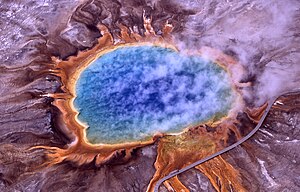When searching for life on other planets, scientists look to the extreme conditions that life can survive in, here on planet Earth.

Hydrothermal vents encrusted with life
It is now commonly thought that life began around hydrothermal vents. These underwater plumes, vent off toxic chemicals and gasses at above boiling temperatures. And yet, in a sea of emptiness these volcanic vents are the only source of life for miles around. The micro-organisms that live and feed there become a source of food for krill and shrimp and who in turn become food form fish and crabs.

A hot spring with bright orange extremophiles
All around the world, volcanic areas, on land, are a hub for extremophiles. Alkaline lakes, similar to the one pictured above, with pH levels of above 9 and Acidic lakes with pH levels or below 3, both with temperatures of over 120°C, support microbes and algae. These microbes truly push the boundaries of extreme living.

Siberian Actinobacteria (by Rachel Sussman)
Extremophiles can be found in the coldest areas of our planet. The ‘Actinobacteria’ (above) lives in the permafrost in Siberia and is among our planets oldest living things. The living sample above is estimated to be between 4 and 6 hundred-thousand years old!

Tullis Onstott is researching life deep beneath the surface
Life isn’t constrained to the surface either, up-to 6 miles down, life thrives. With no light or oxygen these microbes live where ever there is radiation. That’s right, here on the surface we tend to think of radiation as a bad thing, but these microbes depend on it. The radiation from the surrounding rocks breaks down water molecules and the resulting hydrogen gives them something to breath. The rocks also provide them with food, in the form of trace metals. Several teams around the world investigate deep mines and each time they are astonished to find something new. It is estimated that there may even be more life mass underground than over it!
Searching for life in the atmosphere, this plane has a wing attachment (on the very tip) to capture anything that might be floating up there.
Life has even been found high in our atmosphere. Six miles up, scientists found that an astonishing 20% off all particles there, are living organisms. The bacteria and fungi are thought to live off carbon compounds floating in the air and may even play a part in the formation or our weather.
[Sources: Gizmodo: Life in the Atmosphere | Discover Magazine: Microbes that live off Radiation]
